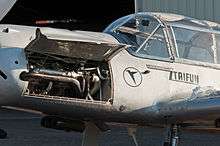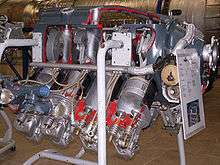Argus As 10
The Argus As 10 was a German-designed and built, air-cooled 90° cylinder bank-angle inverted V8 "low power" aircraft engine, used mainly in training aircraft such as the Arado Ar 66 and Focke-Wulf Fw 56 Stösser and other small short-range reconnaissance and communications aircraft like the Fieseler Fi 156 Storch during, and shortly after World War II. It was first built in 1928.[1]
| As 10 | |
|---|---|
| Argus As 10 installed in a Fieseler Storch at the Royal Air Force Museum Cosford | |
| Type | Piston aircraft engine |
| Manufacturer | Argus Motoren |
| First run | 1928 |
| Major applications | Fieseler Fi 156 Focke-Wulf Fw 56 |
| Number built | 28,700 |
Variants
- As 10C
- As 10C-1
- As 10E
- Optional-output version of the As 10C, delivered with either a 240 PS (177 kW) or 270 PS (199 kW) rating (achieved by increasing maximum rpm).
- As 10E-2
- The proposed powerplant of the Pilatus P-1 trainer project.[2]
- As 401
- Supercharged As 10 with rated output at 3,000 m (9,843 ft), also fitted with hydraulically-actuated variable pitch propeller.
- Salmson 8As-00
- Postwar production of the Argus As 10 in France
- Salmson 8As-04
- Postwar production of the Argus As 10 in France
Applications

Argus As 10c engine in a Messerschmitt Bf 108 Taifun
- Arado Ar 66
- Arado Ar 76
- Dornier Do 12
- Farman F.510 Monitor II[3]
- Fieseler Fi 156 Storch
- Focke-Wulf Fw 56 Stösser
- Focke-Wulf Fw 58
- Gotha Go 145
- Henschel Hs 121
- Kayaba Ka-1 Imperial Japanese Army Observation autogiro
- Klemm Kl 151
- Messerschmitt Bf 108 Taifun
- Rogozarski SIM-XIV-H
- Siebel Si 201
Specifications (Argus As 10 C)

Argus As 10 C, partially sectioned, showing some inner parts
Data from Jane's All the World's Aircraft 1938[4], Flugzeug-Typenbuch. Handbuch der deutschen Luftfahrt- und Zubehör-Industrie 1944[5]
General characteristics
- Type: inverted V-8 air-cooled inverted 90° piston engine
- Bore: 120 mm (4.724 in)
- Stroke: 140 mm (5.512 in)
- Displacement: 12.667 l (772.99 cu in)
- Length: 1,105 mm (43.50 in)
- Width: 880 mm (34.65 in)
- Height: 718 mm (28.27 in)
- Dry weight: 213 kg (470 lb) dry
- 232 kg (511 lb) wet, equipped
Components
- Valvetrain: Two under-head valves per cylinder, operated by pushrods and rockers.
- Fuel system: Two Sun carburetors adapted for aerobatics
- Fuel type: 80 octane
- Oil system: Dry sump, one pressure pump at 1.25–6 atm (1.27–6.08 bar; 18.4–88.2 psi) and two scavenge pumps
- Cooling system: Air
Performance
- Power output:
- 240 PS (237 hp; 177 kW) at 2,000 rpm (5 minutes) at sea level
- 220 PS (217 hp; 162 kW) at 1,940 rpm (30 minutes) at sea level
- 200 PS (197 hp; 147 kW) at 1,890 rpm (max continuous) at sea level
- Specific power: 18.95 PS/l (0.3063 hp/cu in; 13.94 kW/l)
- Compression ratio: 5.9:1
- Specific fuel consumption: 0.23 kg/PS/h (0.51 lb/hp/h; 0.31 kg/kW/h) at max continuous
- Oil consumption: 0.008 kg/PS/h (0.018 lb/hp/h; 0.011 kg/kW/h) at max continuous
- Power-to-weight ratio: 1.124 PS/kg (0.503 hp/lb; 0.827 kW/kg)0.835 kW/kg (0.51 hp/lb)
B.M.E.P.: 7.5 atm (7.6 bar; 110 psi)
gollark: No.
gollark: No.
gollark: Why advanced?
gollark: ↑
gollark: It's a more general conversation than Nazis.
References
| Wikimedia Commons has media related to Argus As 10. |
Notes
- Gunston 1989, p.16.
- Eichenberger, Roland (1989). Pilatus Flugzeuge: 1939–1989 (in German). Stans: Pilatus Flugzeugwerk.
- https://www.aviafrance.com/aviafrance1.php?ID=4603&ID_CONSTRUCTEUR=501&ANNEE=0&ID_MISSION=0&MOTCLEF=
- Jane's All the World's Aircraft 1938. London: Sampson, Low & Martin company Limited. 1938.
- Schneider, Helmut (Dipl.Ing.) (1944). Flugzeug-Typenbuch. Handbuch der deutschen Luftfahrt- und Zubehör-Industrie 1944 (in German) (Facsimile reprint 1986 ed.). Leipzig: Herm. Beyer Verlag. pp. 358–359, 361. ISBN 381120484X.
Bibliography
- Eichenberger, Roland (1989). Pilatus Flugzeuge: 1939–1989 (in German). Stans: Pilatus Flugzeugwerk.
- Gunston, Bill. World Encyclopedia of Aero Engines. Cambridge, England. Patrick Stephens Limited, 1989. ISBN 1-85260-163-9
- Jane's Fighting Aircraft of World War II. London. Studio Editions Ltd, 1989. ISBN 0-517-67964-7
This article is issued from Wikipedia. The text is licensed under Creative Commons - Attribution - Sharealike. Additional terms may apply for the media files.